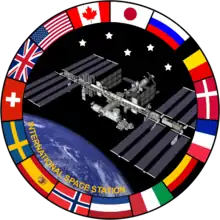Soyuz TMA-15
Soyuz TMA-15 was a crewed spaceflight to the International Space Station. Part of the Soyuz programme, it transported three members of the Expedition 20 crew to the space station. TMA-15 was the 102nd crewed flight of a Soyuz spacecraft, since Soyuz 1 in 1967. The Soyuz spacecraft remain docked to the space station during Expedition 20 and Expedition 21 as an emergency escape vehicle. The mission marked the start of six-person crew operations on the ISS.
| Mission type | ISS crew rotation |
|---|---|
| Operator | Roskosmos |
| COSPAR ID | 2009-030A |
| SATCAT no. | 35010 |
| Mission duration | 188 days |
| Spacecraft properties | |
| Spacecraft type | Soyuz-TMA 11F732 |
| Manufacturer | RKK Energia |
| Crew | |
| Crew size | 3 |
| Members | Roman Romanenko Frank De Winne Robert Brent Thirsk |
| Callsign | Таймыр (Taymyr)[1] or Парус (Parus, meaning Sail)[1] |
| Start of mission | |
| Launch date | 27 May 2009, 10:34:53 UTC[2][3] |
| Rocket | Soyuz-FG |
| Launch site | Baikonur 1/5 |
| End of mission | |
| Landing date | 1 December 2009, 07:17 UTC[4] |
| Orbital parameters | |
| Reference system | Geocentric |
| Regime | Low Earth |
| Perigee altitude | 151 kilometres (94 mi) |
| Apogee altitude | 414 kilometres (257 mi) |
| Inclination | 51.6 degrees |
| Period | 90.16 minutes |
| Epoch | 28 May 2009[5] |
| Docking with ISS | |
| Docking port | Zarya nadir |
| Docking date | 29 May 2009 12:34 UTC |
| Undocking date | 1 December 2009 03:56 UTC[6] |
| Time docked | 185d 15h 22m |

 From left to right; Thirsk, Romanenko and De Winne Soyuz programme (Crewed missions) | |
Crew
| Position[7][8] | Crew Member | |
|---|---|---|
| Commander | Expedition 20 First spaceflight | |
| Flight Engineer 1 | Expedition 20 Second and last spaceflight | |
| Flight Engineer 2 | Expedition 20 Second and last spaceflight | |
Backup crew
| Position | Cosmonaut | |
|---|---|---|
| Commander | ||
| Flight Engineer 1 | ||
| Flight Engineer 2 | ||
Mission highlights

Soyuz TMA-15 was launched successfully by a Soyuz-FG carrier rocket from Site 1/5 at the Baikonur Cosmodrome in Kazakhstan, at 10:34 UTC on 27 May 2009. It docked with the ISS at 12:34 UTC on 29 May 2009.
Roman Romanenko was the third second-generation space traveller. He was reported to have chosen Taymyr (Russian: Таймыр) as the mission callsign because it was the callsign on his father's first flight, Soyuz 26;[1] however, the callsign Parus (Russian: Парус meaning Sail) was used for communications with the spacecraft.[1] Robert Thirsk became the first Canadian to fly on a Soyuz; all previous Canadians in space had flown aboard Space Shuttles. Frank De Winne became the first European to be in command of the ISS.
The craft and crew returned to earth 1 December 2009.
References
- NASA TV coverage of the launch of Soyuz TMA-15, 2009-05-27
- CSA (2008). "Canadian astronauts Julie Payette and Robert Thirsk to go on space missions in 2009". CSA. Archived from the original on 14 February 2009. Retrieved 27 February 2008.
- NASA. "Consolidated Launch Manifest". NASA. Retrieved 28 March 2009.
- NASA (24 November 2009). "NASA TV to Broadcast Space Station Crew Soyuz Landing Events". NASA. Retrieved 1 December 2009.
- McDowell, Jonathan. "Satellite Catalog". Jonathan's Space Page. Retrieved 6 January 2014.
- Zak, Anatoly. "Mission of Soyuz TMA-15". RussianSpaceWeb. Retrieved 6 January 2014.
- NASA (11 February 2008). "NASA Assigns Crews for STS-127 and Expedition 19 Missions". NASA. Retrieved 11 February 2008.
- ESA (2008). "Frank De Winne prepares for new mission". ESA. Retrieved 3 November 2008.
External links
| Wikinews has related news: |


